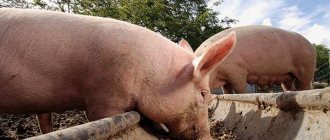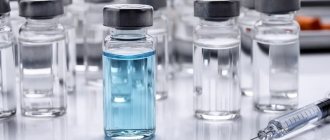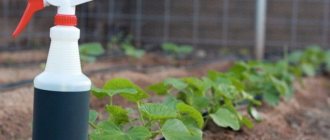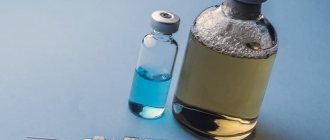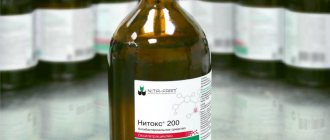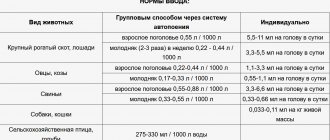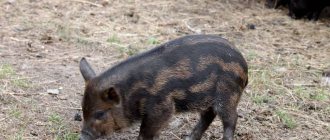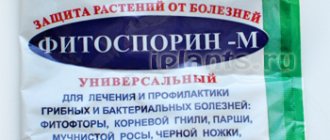Pig breeding is a fairly popular and effective area of animal husbandry. However, these animals constantly face the risk of ingesting helminth eggs and larvae. This provokes negative consequences both for the health of the pigs themselves and for the person consuming animal products. Tetramizole 10 is an effective veterinary drug used as an anthelmintic in the treatment of numerous diseases of livestock, including pigs.
Indications for use of Tetramizole
The medicine has a nematode effect on the animal body and helps to cope with a number of parasites, including:
The drug is used in the prevention and treatment of the following pathologies:
- hemonchosis;
- dictyocaulosis;
- heterokidosis;
- ascariasis;
- strongyloidiasis, nematodiosis in goats and sheep;
- metastrongylosis, ascariasis and other nematoses of the gastrointestinal tract of pigs;
- capillariasis, amidostomiasis and other parasitic diseases in birds.
The use of the medication has a fairly wide range of indications, which are reflected in the instructions for use.
Important! Water may be required to prepare the mixture, so the drug is added to food after the food is ready.
Rules and shelf life
The drug is produced in Croatia. Manufacturer Veterina Ltd. The instructions for the medicine indicate the shelf life (2.5 years), and the date of manufacture is on the packaging. If the storage rules are followed, Tetramizole retains its medicinal properties for 2.5 years. Standard storage requirements:
- lack of direct sunlight;
- normal air humidity;
- air temperature not higher than 30 °C;
- lack of nearby food products.
Children and pets should not have access to the drug packaging.
Doses and method of administration, instructions
Application in each specific case requires a clear dosage. The drug has a fairly aggressive effect on the body, and therefore an overdose is unacceptable.
For the birds
The medication is administered orally in a single dose to one bird. The substance is supplied by a dispenser or other device.
Tetramizole is given at the rate of 20 mg per 1 kg of weight. If mass treatment is required, then you need to add the drug to the feed (approximately 5 g of drug-treated food per individual).
The mixture should be placed in the feeder, while ensuring access to it.
Important! Before mass deworming, Tetramizole must be used on a group of 5-10 animals. If there are no complications within 2-3 days, then everyone can be treated.
For pigs
In pigs, a dosage of 10 mg/kg is suggested. For mass treatment, it is necessary, as in the previous case, to mix the product with food, but at the rate of 50-100 g of food per animal.
Tetramizole powder
The composition is laid out evenly in the feeders so that all animals have access to it.
The piglets should be approximately the same weight if they are fed together. Weakened individuals need to be fed and treated separately.
Pregnant sows are treated approximately 3 weeks before farrowing. After use, animals are washed to remove helminth eggs from the skin.
If animals are grazed on pasture, they are transferred after processing to a new place.
Important! After treatment and washing, animals should be immediately transferred to a clean room. The contaminated room is disinfected and cleaned.
Animal milk should not be used on the first day after treatment, and meat should not be used for the first week. Only after 7 days from the date of use of Tetramizole 10 in pigs, chickens, and cattle, meat will be acceptable for human consumption.
The drug Tetramizole detailed instructions for use in veterinary medicine
Dosages of the drug depend on the type of livestock or poultry, as well as on what percentage of the active substance is included in its composition. The instructions presented later in the article are suitable for Tetramizole 20%.
This drug can be used for both individual and group treatment. In the first case, the drug is usually given to the animal orally with a drink using a dispenser syringe. If it is necessary to treat the entire herd, the drug "Tetramizole" is added to the cattle's food in the morning feeding. In this case, the medicine is first tested on a small (4-10 heads) group of pigs, sheep, cows, etc. In the absence of any complications, after three to four days the actual treatment of the herd begins.
During mass therapy, the drug is weighed out for groups of animals of several animals each (up to 100) and thoroughly mixed with food. Next, the food is laid out in feeders and the livestock or poultry are provided with free access to them.
Thus, we found out what the instructions for use in veterinary medicine are for the drug Tetramizole. The dosages required in this or that case can be seen in the table below.
Helminthiasis in poultry manifests itself in a significant loss of productivity. Chickens, geese, and turkeys, despite high-quality nutrition, gain weight poorly, lay eggs worse, and become sensitive to various diseases. In addition, they pose a threat to human health. Veterinarians recommend antihelminthic drugs for birds at the first signs of disease in animals. Among all their variety, Tetramizole is recognized as one of the best drugs, characterized by ease of use, although to avoid side effects it is necessary to strictly follow the instructions. Recommended dosages, risks and contraindications will be discussed below.
Helminthic diseases of pigs
The most common pathologies in pigs are bacterial and parasitic. Among the latter, animals often suffer from the following ailments:
1. Ascariasis. Occurs as a result of the pathogenic activity of roundworms. The worms infect young animals between 3 and 6 months old. They lay eggs in the small intestine and are then passed in the feces. Once in the soil, food or water, they ripen. Infection occurs by eating contaminated food. Grazing on pastures in which the soil is saturated with parasites is also dangerous. After re-entering the body, the larvae hatch and penetrate through the intestinal walls into the lungs, circulatory system and oral cavity. Simultaneously with saliva, they move into the intestines and lay eggs. While in the gastrointestinal tract, roundworms produce poisonous toxic elements.
Roundworms
Symptoms:
- stool disorder;
- loss of appetite;
- temperature increase;
- lethargy;
- intermittent breathing;
- weight loss;
- anemia;
- teeth grinding;
- cough.
In severe cases, inflammation of the lungs or liver occurs. Sometimes allergic reactions such as skin rashes and nervous attacks are present. Less commonly, blockage and subsequent rupture of the intestine occurs.
Roundworms can cause pneumonia
2. Finnoz. In everyday life - semolina. Occurs after tapeworm larvae enter the body. Pigs become infected through contact with human feces. After entering the gastrointestinal tract, the worms penetrate the muscles and form blisters resembling cereal grains. The pathology has no specific manifestations.
Contaminated Meat
3 . Trichinosis. It is caused by tiny trichinella. The main source of infection is the corpses of rats. While in the small intestine, the worms give birth to larvae, which are carried throughout the body through the circulatory system. Once in muscle tissue, they curl into capsules. They can remain in this situation for up to 25 years.
Symptoms:
- diarrhea;
- increase in body temperature;
- vomiting spasms;
- muscle pain;
- reduction in body weight.
Rats are the main carriers of the disease on home farms
4. Metastrongylosis. A helminthic pulmonary pathology manifested by bronchopneumonia. Round helminths parasitize in the bronchial lumens. The life cycle of helminths occurs with the help of an earthworm, which is an intermediate host. When ingested by a pig, the larvae that were in it are released and complete their development in the bronchi.
Symptoms:
- coughing;
- wheezing;
- dyspnea;
- gradual increase in temperature to 42°C.
In piglets up to 6 months of age, the disease occurs in an acute form.
Animals with mild pathology have no clinical signs.
Developmental pattern of metastrongylids
5. Strongoloidiasis. The disease is caused by nematodes that settle in the mucous membrane of various parts of the intestine. They mainly attack the organisms of piglets. The pathology is accompanied by pleurisy, bronchopneumonia, and, less commonly, cachexia and developmental delay.
Symptoms:
- severe diarrhea;
- vomit;
- rapid weight loss;
- eczema;
- skin rash and itching;
- scabs on the body;
- increase in body temperature to 40.7°C.
In advanced form, symptoms of pleurisy or pneumonia appear. Possible death. In adult pigs, the pathology is asymptomatic.
Tetramizole successfully copes with most of them.
The influence of parasites on the pig body
Several types of pathogenic intervention are known. They are determined by the physiological specificity of animals and helminths, as well as the location of the latter.
Table 2. Effect of parasites on the body
| Type | Characteristic |
| Mechanical | It is provoked by the migration of larvae throughout the body and their concentration in organs or muscle tissues. During this process, tissues are deformed, which can lead to rupture of capillaries. As a result, acute inflammatory processes begin. With a massive accumulation of helminths, the intestines become clogged and ruptured, as well as the accumulation of pus in the organs. Such processes end in death. Some varieties of worms attach themselves to the walls of organs using suction cups, which is dangerous due to acute inflammation. While in red blood cells, parasites destroy their structure. This causes rapid deterioration in physical condition. |
| Toxic | Due to the prolonged presence of the parasite in the animal’s body, the latter develops liver toxicosis. Such exposure leads to a deterioration in appetite, digestive processes, as well as a decrease in the number of red blood cells and hemoglobin. |
| Allergic | Occurs as a result of the release of waste products of helminths into the body. They are allergens consisting of polypeptides and complex polysaccharides. The effect of these elements on the body leads to eosinophilia. |
| Trophic | Some helminths feed on the contents of the intestines, some on blood. With a large accumulation of helminths in the body, death is possible. |
| Inoculatory | During their development, the larvae infect pigs with certain types of microbes. Through mechanical injury to the mucous membranes, they enter the circulatory system. This is fraught with the development of infectious pathologies. |
Infection of humans with helminths from pigs
Parasites found in meat can cause serious damage to the human body. This is especially true for eating foods that are lightly cooked. To avoid danger, you should buy products from a trusted supplier and prepare them correctly. When breeding pigs, it is first necessary to monitor the physical condition of the livestock.
Science knows many varieties of helminths that are transmitted from animals to humans. Some enter the body by accident. However, for most people, the person becomes the primary carrier. It is inside the gastrointestinal tract that helminths become sexually mature and begin to destroy organs and tissues.
Infection with worms occurs both through contact with an animal and through eating meat
Among the most dangerous parasites are the following:
- protozoa - sarcosporidium and toxoplasma;
- roundworms - Trichinella and Toxocara;
- tapeworms - bovine and pork tapeworms, echinococci.
Types of parasites
In addition, pigs become infected by eating cockroaches and flour beetles. These insects often carry tapeworm eggs, which contribute to the development of hymenolepiasis in humans.
Symptoms of worms in birds
It is easy to determine the presence of parasites in birds based on a number of signs.
The drug Tetramizole 10
Mainly noted:
- developmental delay;
- sickly appearance;
- lethargy, weakness;
- refusal of food;
- severe exhaustion;
- wheezing when breathing;
- paralysis and seizures;
- decreased egg production;
- change in the color and consistency of the droppings (greenish, yellowish, liquid).
Even the presence of several symptoms should alert you. It is recommended that the sick animal be shown to a veterinarian, but in any case, anthelmintic therapy will be necessary.
Caring for sows and piglets
Caring for the sow and piglets
During pregnancy, it is enough to feed the pig no more than once a day.
At home, farrowing of sows is often accompanied by complications.
Before farrowing, you need to prepare the following:
- Wipes that must be sterile and clean.
- Iodine solution, which is required for disinfection.
- Hot water will be required.
- Scissors.
- Gloves should be elbow-length.
- You will need a cord to tie the umbilical cord; it must be strong.
After the pig has found the place where it is going to give birth, it freezes, then it begins to push.
The birth of the first piglet is the most difficult for a sow compared to others. The farrowing process will be long, difficult and painful. Usually the piglet comes out within six hours.
The kids come out one by one. The interval between their appearance is usually approximately 25 minutes.
Important! When helping with farrowing, the farmer must take into account that the uterus of pigs is bicornuate. Little piglets appear alternately on one side or the other
If the sow is healthy, then she does not need help pushing the piglets out. In this situation, the farmer needs to deal only with piglets.
If farrowing lasts longer than expected, this means that the animal needs help. However, you need to understand that this situation poses a serious danger. If the required assistance is not provided in time, not only the piglets, but also the sow may die.
In this situation, you need to do the following:
- Put a glove on your hand, which must be thoroughly lubricated with Vaseline.
- Then you need to penetrate the sow's vagina with your hand. Slowly moving it forward, you need to penetrate deeper and deeper until you can touch the piglet.
- Then you need to freeze, gradually waiting for the push.
- During its onset, it is necessary to gradually move the piglet outward through the uterus, helping to give birth.
On a note. After farrowing has ended, special attention must be paid to newborn piglets. To do this you need:
To do this you need:
Immediately after birth, dry each baby thoroughly with a clean, dry towel. At the same time, they need to be carefully examined, freeing the nose and mouth from mucus. After this is done, you need to pay attention to the umbilical cord. It needs to be trimmed
In this case, it makes no sense to leave too large a segment. It is generally believed that the umbilical cord should be cut at a distance of two centimeters. The end of the umbilical cord must be tied tightly with a pre-prepared cord. Then the location. Where it was cut needs to be treated with iodine solution.
On the first day of life, piglets need to be given injections, with the help of which the body's iron supply will be replenished. If this is not taken care of, the cubs may develop iron deficiency anemia.
On a note. After the piglet comes out, you need to pick it up and bring it to the sow's nipple
It is important that before the first 45 minutes of a baby's life have passed, each of them has drunk their mother's colostrum.
This provides powerful support for improving the immunity and vitality of the new generation. This can be done even while the piglets have not finished being born. These actions help make pushing less tiring and painful for the sow.
Babies will be cold immediately after birth. To protect them from the cold, you need to place them under the light of an infrared lamp.
In addition, it is important that the piglets are born in a warm room.
Newborn pig
After farrowing, the pig may experience a discharge called lochia for five days. At first, their hue is reddish. Over time it becomes brown. Then gradually the discharge loses color and becomes transparent. Soon they disappear.
When childbearing ends, in the first hours, rest and the opportunity to drink water are of great importance for the sow.
On a note.
When 7-8 hours have passed, the sow can be fed liquid mash. But in this case a problem may arise: the pig after farrowing does not eat what to do. On the one hand, the mother needs to gain strength, on the other hand, sometimes she refuses to eat.
In this case, it is recommended to give her food that is high in energy, having previously dissolved it in water. For this purpose, you can dissolve sugar in water and give the sow to drink the liquid. Soon she will be on her feet.
Composition and effect of the drug
You can buy Tetramizole 10 in different packages at a veterinary pharmacy or veterinary clinic. It is sold both in small, sealed boxes of 100 g, and in foil bags from 150 g to 1 kg (capsules). For owners of large livestock, medicine packaged in 10 kg plastic buckets is suitable.
After taking the powder, it is absorbed very quickly and begins to act as effectively as possible, destroying helminths. The very next day it is excreted from the body along with urine and, partially, feces. In addition to exterminating worms, Tetramizole 10 has a therapeutic effect on areas that have been affected by parasites. After taking it, you can notice an increased appetite and better absorption of feed by livestock.
Danger to humans and preventive measures
Most types of helminths that infect chickens are also dangerous to humans.
These parasites are transmitted to people when hygiene rules are not observed when working in a poultry house, or when eating meat and eggs (if worms have infected the laying hen's oviduct) that have not undergone strong enough heat treatment.
When there is a suspicion that the product was obtained from a sick bird, it is better to discard it.
Anthelmintics are best given to chickens in drinking bowls with water.
To avoid infection with chicken worms, the poultry farmer must observe the following preventive measures:
- wash your hands with soap and warm or hot water after each visit to the chicken coop;
- carry out timely preventive anthelmintic treatment of chickens;
- exclude feeding birds from your dishes.
Preventive measures against worm infection in chickens include:
- timely cleaning of the poultry house;
- maintaining normal humidity in the chicken coop;
- monitoring the condition of the bird;
- exclusion of communication between poultry and wild birds;
- protecting the poultry house from rodents;
- giving anthelmintic drugs for preventive purposes;
- isolation of sick chickens from healthy ones until complete recovery.
If chickens are properly kept, there is no acute problem with worms: preventive measures give a good result, allowing you to effectively protect your feathered pets from parasitic worms.
Description of Tetramisole
It is used to expel from the body many varieties of helminths that invade the gastrointestinal tract of large, small ruminants and livestock.
After penetration into the body of the parasite, the drug has a destructive effect on the central nervous system. The result is paralysis and death.
The product is fast-acting. The effect on worms stops 2 days after taking it. It is eliminated from the body over several days.
Tetramizole is an anthelmintic drug with a wide therapeutic range.
In pigs affected by lung nematodes, the cough intensifies 15 minutes after taking the medication. This indicates that the active substance effectively affects parasites. Side symptoms disappear within 24 hours.
Diarrhea caused by the activity of gastrointestinal helminths lasts no more than 2 days after administration of the drug. Simultaneously with the restoration of the digestive system, the pigs' appetite returns.
Tetramizole kills helminths, but does not cure the consequences caused by them
Composition and release form
The product is produced in 10% and 20% concentrations. Available in the form of granular powder and aqueous solution.
Tetramisole is an insoluble form of Nilverm. A 10% equivalent of 1 kg contains 100 g of the active substance - tetramizole hydrochloride.
Packaging is carried out in containers from 50 to 10,000 g, which are double plastic bags, paper containers, plastic jars, buckets and bottles.
Tetramizole acts on worms parasitizing the gastrointestinal tract and lungs
Pharmacological properties
The main element of the drug is based on a combination of 2 isomers. Inactive right-handed and active left-handed - levamisole.
The principle of action of the anthelmintic is based on the intensification of the activity of the ganglia located in the central nervous system of the worms. In addition, the functions of certain enzymes are blocked. This effect leads to paralysis and death of the worms. The required concentration of the drug in the body is observed 1 hour after taking it and remains in the required volume for up to 1 day. It is released along with urine and feces.
The product kills both mature and immature forms of helminths
Indications for use
Prescribed for the prevention and treatment of the following parasitic diseases in pigs:
- trichocephalosis;
- ascariasis;
- measles;
- esophagostomosis;
- metastrongylosis;
- strongyloidiasis;
- trichinosis.
In most cases, it is possible to completely cure the livestock.
Overdose is dangerous for animal health
Dosage and method of administration
To achieve the best effect from Tetramizole, you must strictly adhere to the instructions specified in the instructions.
The product is used without the use of laxatives or a preliminary starvation diet. Both individual and group therapy are available.
Reception method for pigs:
- When administering medication on a mass scale, pigs should be approximately the same weight category.
- The drug is mixed with feed at the rate of 1.5 g per 10 kg of piglet weight. The maximum dose for one individual is 45 g.
- Before group deworming, the medication is tested on a small group of animals. If no complications are observed within 3 days, treatment of the entire livestock begins.
- Each pig should have free access to a feed trough.
Give the drug in the morning feeding
Due to the low toxicity of the drug and the wide therapeutic range of use, the likelihood of toxic reactions occurring is extremely low
Side effects
The product belongs to the category of moderately toxic drugs. In a therapeutic dose it does not have a mutagenic effect. In rare cases, an allergic reaction develops. It is caused by the presence of individual intolerance to the active substance.
With the correct dosage, side effects are rare
Contraindications for use
There are several restrictions on the use of the product:
- Individual intolerance to the components of the medication.
- Pigs infected with infectious pathologies.
- Females in the last trimester of pregnancy.
- Animals with renal or hepatic dysfunction.
The simultaneous use of Morantel, Pyrantel and organophosphorus substances is also not recommended.
Veterinarians do not recommend combining Pyrantel and Tetramizole
special instructions
Given the specifics of the drug, there are a number of precautions that must be observed:
- Pigs can be slaughtered for meat 72 hours after taking the drug.
- Before the designated period, it is better to use meat as a basis for meat and bone meal or feed for fur-bearing animals.
- If the product gets on the mucous membranes of the eyes or skin, treat the affected area with plenty of water.
Treat the affected area with plenty of water
Tetramizole must be stored in a place protected from sunlight. The place must be inaccessible to children. It is advisable not to place it near food products. The optimal indoor air temperature is up to 30°C. Shelf life - 2.5 years.
Pharmacological properties
The active ingredient of the drug is tetramizole, a broad-spectrum nematocide.
Tetramizole is active against mature and immature forms of gastrointestinal nematodes: Ascaris suum, Ostertagia spp., Haemonchus spp., Trychostrongylus spp., Chabertia ovina, Cooperia spp., Nematodirus spp., Bunostomum spp., Strongyloides papillosus, Oesophagostomum spp., Trichocephalus spp., pulmonary nematodes: Dictyocaulus spp., Müllerius capillaries, Metastrongylus spp.
The mechanism of action of the drug is to enhance the cholinomimetic activity of the ganglia in the nervous system of the parasite, blocking the enzymes fumarate and succinate reductase, which leads to paralysis and death of the nematode.
After oral administration, tetramizole is quickly absorbed from the gastrointestinal tract, the therapeutic concentration of the drug is achieved in organs and tissues after 1 hour and remains in the body for at least 24 hours.
Tetramizole is excreted from the body mainly through urine, partly through feces.
In terms of the degree of impact on the body of warm-blooded animals, the drug is classified as a moderately hazardous substance and in recommended doses does not have a locally irritating, resorptive-toxic or sensitizing effect.
Application and dosage
- For dogs and cats - 1 time 0.075 g / 2 kg of animal weight. Dogs and cats should be treated 3-4 days before vaccination and once every 3 months.
- For poultry – 1 time, 1 g/5 kg of weight, with feed once in the 2nd half of the growing period.
- For cattle, sheep, goats and pigs, the drug is given once with food in a dosage of 0.075 - 0.15 g per 1 kg of animal weight. Cattle must be treated with the drug 2 times a year, young animals - 7 days after being put out to pasture.
- Treat pigs once in the 2nd half of the growing period, sows – once 14 days before farrowing; sheep and goats – 2 times a year (before pasture and before wintering); ewes 4 - 6 weeks before lambing and again (after weaning the lambs); Lambs are treated once after weaning from the ewe.
Possible contraindications
An anthelmintic drug should not be given in parallel or at the same time as other medications. This can cause drug allergies. Other medications can be given 3 days after therapeutic deworming.
"Tetramizole" cannot be used if the pig was treated with drugs containing organophosphorus compounds after therapy with "Pyrantel", "Morantel" . Anthelmintic therapy is contraindicated in infected animals and sows in the last 2 weeks before farrowing.
See also
Rules for breeding piglets at home for beginners, profitabilityRead
Active substance
This drug has a number of active ingredients, the basis of the drug is Tetramizole. This is a powerful nematicide with wide functionality. Thanks to it, the medicine is able to fight not only adult individuals, but also the larvae of helminths and nematodes. The substance is dispensed in the form of small granules. The powder is white in color and has a barely noticeable odor. Tetramizole 10 can quickly rid pigs of worms at home, without the help of a veterinarian. The effectiveness of the drug directly depends on the correct dosage.
The note! If you sell live pigs, you simply need to ensure that the animals do not lose weight, therefore treatment and prevention of helminths using Tetramizole 10 is a necessary procedure.
Review of anthelmintic drugs video
In every agricultural or farming enterprise, sooner or later there comes a need to treat animals for parasites and worms. For these purposes, scientists have developed a special harmless drug “Tetramizole 10”, which can be used for birds, pigs and cattle. The main thing is to know how much the medication is and carefully monitor the dosage!
Tetramizole 10 is an innovative drug in the form of powder or granules, which helps in the treatment and prevention of pets not only from helminths, but also from the following misfortunes:
- Dictyocaulosis;
- Hemonchoz;
- Bunostomiasis;
- Nematodirosis;
- Ostertagiasis;
- Habertiosis;
- Cooperiosis;
- Strongyloidiasis;
- Ascariasis;
- Esophagostomosis;
- Strongyloidiasis;
- Trichocephalosis.
Application of Tetramizole for pigs
Application of medicine
The substance is taken orally. It is given to pigs either diluted with water or added to wet food. The mixture is thoroughly mixed and poured into the trough. Use Tetramizole 10 in the morning, along with the mash. At this moment, the animal is hungry, and therefore will eat absolutely all the food from the feeder, which guarantees the high effectiveness of the medicine. The dosage is very simple. For every 10 kg of pig weight, you need to give it 1.5 g of pellets. It is very important to adhere to these indicators, since an overdose of the drug can cause a number of serious complications.
Important! The maximum amount of Tetramizole 10 per head is 45 g. If you exceed this mark, it can cause allergic reactions in the animal.
Use group administration of the drug. In this case, it is necessary to ensure that all piglets have enough space at the trough to receive the same dose of the substance. But the group treatment method is not suitable in cases where there are sick or weakened animals in the herd. Such pigs must be separated from the rest of the litter and fed individually in order to achieve maximum results from Tetramizole 10.
Medicine for pregnant queens is given 3 weeks before farrowing; in the later period, the substance ceases to have any effect on the pig’s body. If you do not use the medicine at all, there is a high probability that helminths or pulmonary nematodes will infect the still-born brood, which will significantly complicate treatment. 2 weeks after giving birth, the sow and her young animals are transferred to a clean barn, and the barn is treated with lime in order to get rid of worms that came out of the pig’s body after using the drug.
The note! The medicinal substance has a wide spectrum of action; it treats livestock and poultry against helminths, in accordance with the instructions.
Pigs are treated with Tetramizole 10 once a year, at 4-6 years of age. After the first use of ten percent tetramizole, did you notice any changes? Use a stronger concentrate of the drug - Tetramizole 20.
Side effects
Most experienced pig breeders note that the medicine has almost no side effects, although in veterinary medicine there have been cases of individual allergic effects of the substance, which were due to the characteristics of the pig’s immune system. Basically, the negative effect of the drug manifests itself after exceeding the dose, which is affected by the same allergic reactions.
Notes
There are a number of notes on the use of the drug that must be followed so as not to harm yourself and the animal.
- Do not mix the medicine with other substances, as this may cause an allergic reaction.
- Did you start diluting Tetramizole 10 in water and the solution got into your eyes? It is necessary to rinse them immediately with warm water to prevent burning the retina.
- After the procedure, you must wash your hands thoroughly; the potent substance tetramizole can cause dry skin due to its complete degreasing.
- You can inject pigs 3-4 days after using the medicine.
Proper treatment will give positive results in the first hours. Tetramizole 10 is suitable for absolutely all breeds of pigs, be it Yorkshire, Duroc, Vietnamese Fold, Large White or any other. The drug also treats large and small livestock and poultry.
The shelf life of the substance is 5 years, provided that it is properly stored in a dry place, away from sunlight. You should keep the drug away from children. Storage temperature should not exceed 30 degrees.
Despite the large and detailed instructions for Tetramizole 10, there are still a number of most asked questions regarding this drug.
- Is it better to dilute the powder with water or mash?
- The ideal option is a mash: a portion that the pigs will eat within an hour.
- How many times a day should I give the drug?
- The medicine is administered once, and then the animal is monitored. If there are no results, the procedure can be repeated after 3 days.
- How much is Tetramosyl 10 in a teaspoon?
- Like any other drug - approximately 5 g.
- What is the method of using medicine with water?
- The pig's head is raised slightly upward, a dosing syringe is inserted into the throat and the drug is forcibly injected into the body. Effective, but not the easiest way.
- What is the price of the substance on the market?
- From 2.5 to 5 dollars, depending on volume.
- How to weigh pellets correctly?
- Use electronic scales.
That's all you need to know about Tetramizole 10. Now you know how to give the medicine, how to store it and how to use the drug correctly without harm to yourself and the animal.
Form, composition
TETRAMIZOL 10% and 20% water-soluble powder contains 100 or 200 mg of tetramizole hydrochloride as active ingredient in 1 g, respectively.
TETRAMIZOL 10% and 20% is produced in the form of a homogeneous powder according to
in double plastic bags, polyethylene-coated paper bags, plastic cans or plastic buckets.
Are there any analogues?
Other veterinary drugs are produced against pulmonary and intestinal nematodes and are used for deworming pigs:
- "Levamisole" 75. The injection solution is injected under the skin, it begins to act 30 minutes after the injection. The drug destroys larvae and mature individuals. The maximum single dose is 20 ml. The active substance is completely eliminated from the body after 7 days.
- "Nilverm" 20. Active substance tetramizole. The anthelmintic drug is given once to fattening pigs at a dose of 75 mg per 1 kg of weight. The deadline for sows is 2 weeks before farrowing. 20 is contraindicated for boars.
- "Baymek." The active antihelminthic substance is ivermectin. The product is produced in the form of a 1% solution, packaged in glass containers. Pigs are injected once into the occipital region. The deadline for sows is 4 weeks before the start of lactation. Piglets can be slaughtered a month after treatment.
We suggest you read: How to use hawthorn to treat hypertension
Tetramizole analogues are stored in a dry place, protected from light. They do not have pronounced side effects. If the dosage is observed, they do not harm animals.
Treatment of helminthiasis in pigs
If a helminthic infestation is suspected in piglets or adult pigs, it is important to begin treatment immediately. It should be understood that most types of helminth infections pose a danger to humans
Having discovered alarming symptoms in an animal, you need to call a veterinary service worker, since he must determine what type of helminthiasis the pig is suffering from. Treatment can be carried out using special medications and folk remedies. The first method is much more effective than the second.
The most effective in treating various types of helminthiases in animals are drugs based on albendazole and fenbendazole. They are available in the form of powder, suspension, tablets and injections:
- Febtal;
- Cestal;
- Brovadazole;
- Oxylur;
- Panacur;
- Dirofen;
- Alben;
- Albentabs;
- Atazolcept;
- Pratazol;
- Nilverm (injections against worms for pigs) - administered subcutaneously.
These drugs are effective against most types of nematodes, cestodes, trematodes, tapeworms and their larvae. Before using medications, you should consult a veterinarian and carefully study the instructions. Each of these drugs can cause side effects - drowsiness, apathy, however, the condition of the animals soon improves. Anthelmintic treatment is carried out twice.
To give a piglet deworming tablets, they are first crushed and mixed into a small portion of the feed.
It is important that the animal eats it exactly. If a group of animals is being treated, it is easier to use drugs in powder form, which are mixed with a certain amount of food.
The daily portion of feed on the day when deworming is carried out is reduced by half, and after taking the medicine, the pigs are not allowed to eat for several hours (5-7).
The most effective against helminths are injectable medications. When using them, you can be sure that the sick individual has received the required dose of the substance.
The most effective folk remedies are garlic and tansy herb. However, it is better to use them for the prevention of helminthiases, and it is still worth treating sick individuals with drugs. Garlic is introduced into the diet of pigs every day. It is enough for piglets to eat up to 50-100 grams of vegetables along with the feed.
Tansy is effective against worms
The tansy plant is also used to treat worms in pigs. Small piglets weighing less than 30 kilograms are given one teaspoon of dried grass every day.
Worms in piglets are a dangerous phenomenon. Worms parasitizing the body of a young animal deprive the growing body of nutrients, weaken the immune system, and cause intoxication. All this leads to exhaustion and sometimes death of livestock
For a farmer, this situation is unprofitable, so it is important to learn to recognize the signs of worm infection and take action immediately. Treatment for helminthiases should be prescribed by a veterinarian, and the farm owner should follow all his instructions and promptly deworm the livestock.
Pigs have been kept as farm animals since ancient times. Due to the high calorie content of meat and fat layer, they are often bred by both large enterprises and private livestock breeders. Like most domestic animals, artiodactyls are susceptible to infection by various parasites.
Worms in pigs
Among harmful organisms, roundworms come first. Worms can appear in pigs for various reasons, but most often this occurs due to violation of sanitary standards, poor-quality feed and lack of prevention. In the treatment of ascariasis, both medications and traditional methods are used.
Vaccination against swine fever
Classical plague is first on the list of dangerous diseases of pigs. This infection is caused by a virus that affects 95–100% of unvaccinated livestock. The mortality rate is 60–100% of the number of cases! Other animals do not suffer from this infection; it is dangerous only for domestic pigs and wild boars. When plague occurs on a farm, all sick people are killed and the corpses are burned. Therefore, outbreaks of infection cause great damage to pig farms.
Vaccination of piglets against swine fever is mandatory. One of the following vaccines is used for vaccination:
- "KS";
- "ABC";
- VGNKI virus vaccine;
- virus vaccine LK-VNIIVViM.
The vaccine is given intramuscularly according to the following scheme:
- the first on days 45–47;
- the second at 120.
But sometimes it is advisable to vaccinate piglets at a later age - at 65 and 145 days from birth.
Revaccination against swine fever is carried out every year.
